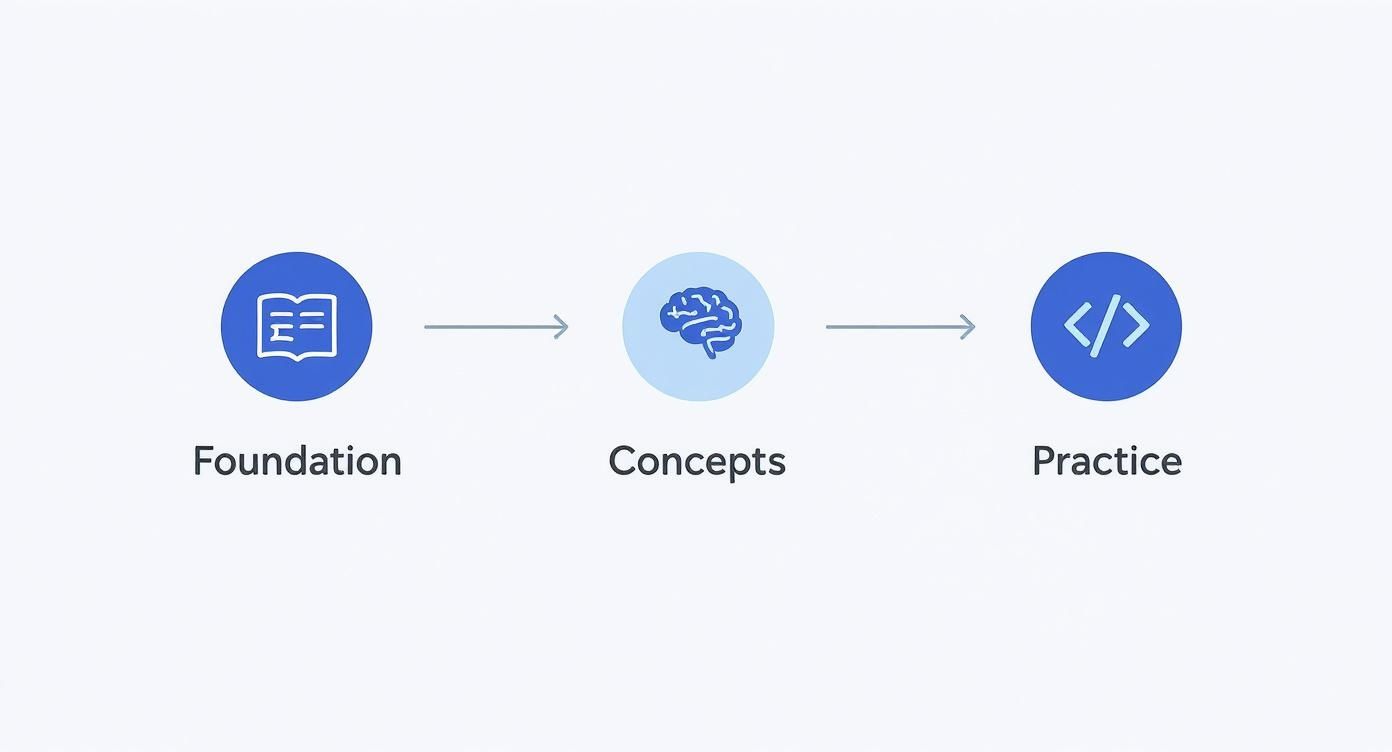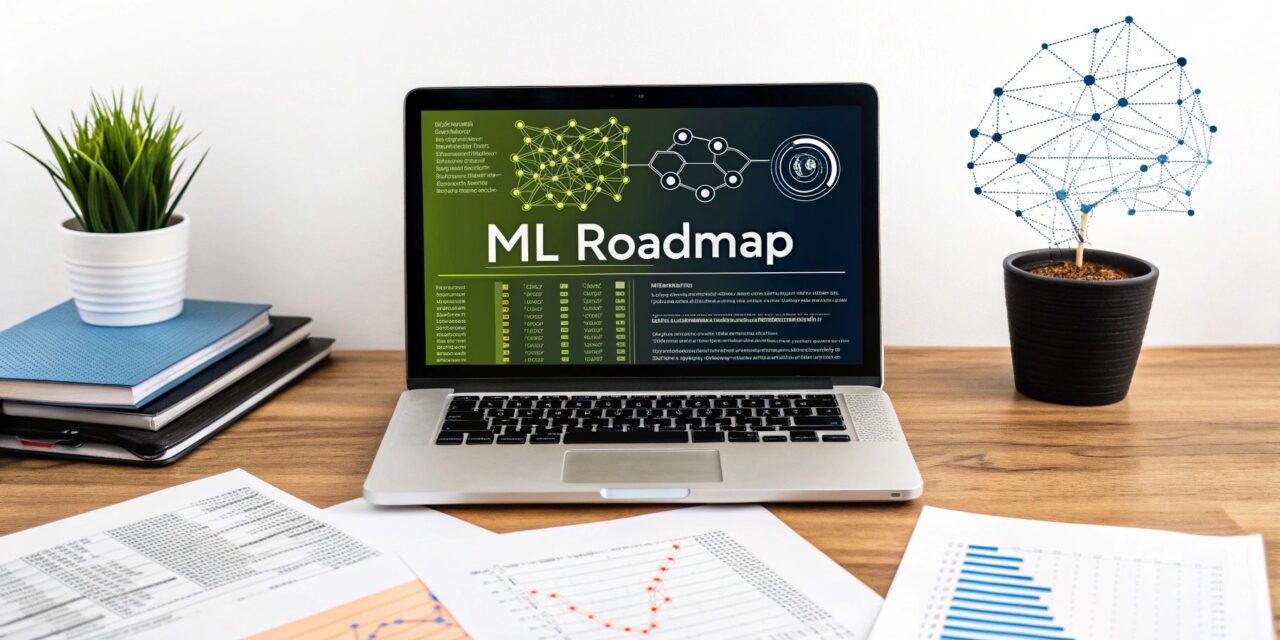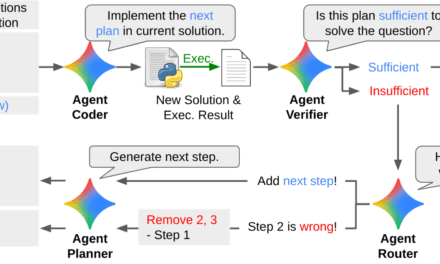So, you're wondering how you can learn machine learning? That's a great question, and I'm happy to tell you the answer is probably more straightforward than you imagine. It's not about memorizing every complex algorithm overnight. It's about following a structured plan: nail the fundamentals, grasp the core concepts, and then get your hands dirty with real projects.
Your Path to Mastering Machine Learning
When you first dip your toes into machine learning, it's super easy to get swamped by a tidal wave of jargon. Terms like "neural networks" or "gradient descent" can feel intimidating, making you think you need a Ph.D. just to get started.
Let me be clear: that’s not the case. The journey into ML is a practical one. It’s built on curiosity and consistent effort, not just a wall full of degrees.
The trick is to avoid trying to learn everything at once. Instead, follow a clear roadmap. This guide is that roadmap, designed to take you from zero to confident without the overwhelming academic-speak. We're going to build your skills from the ground up, step by step.
Understanding The Learning Journey
Breaking into machine learning really comes down to three phases: building a solid foundation, understanding the core concepts, and then putting it all into practice. This visual lays out the entire process nicely.

As you can see, true mastery isn't just about theory. It's about layering that knowledge with hands-on application, progressing from the basics to actually building things that work.
Your Machine Learning Roadmap at a Glance
To give you a clearer picture of the path ahead, here's a quick overview of the key stages this guide will walk you through. Think of it as a high-level map for your journey.
| Stage | Focus Area | Key Skills to Acquire |
|---|---|---|
| Stage 1 | The Foundation | Python programming, core math (linear algebra, calculus, stats), data manipulation with libraries like Pandas & NumPy. |
| Stage 2 | Core ML Concepts | Supervised vs. Unsupervised Learning, model evaluation metrics, feature engineering, understanding key algorithms. |
| Stage 3 | Hands-On Practice | Building projects from scratch, participating in Kaggle competitions, creating a portfolio of your work. |
| Stage 4 | Specialization | Deep learning, Natural Language Processing (NLP), Computer Vision, or Reinforcement Learning. |
Each stage builds on the last, ensuring you develop a well-rounded and practical skill set ready for real-world challenges.
Why Now Is The Perfect Time to Start
Let's talk about timing. The demand for machine learning expertise has absolutely exploded, and it’s not just a passing trend. It's a fundamental shift in how entire industries work.
The machine learning market was valued at around $55.8 billion in 2024 and is on track to hit an estimated $282 billion by 2030. That incredible growth is happening because sectors from healthcare and finance to retail and automotive are leaning on ML to innovate and stay competitive. To meet that demand, you need practical skills—data preprocessing, model building, and deployment—along with a solid grasp of Python and math fundamentals.
Expert Opinion: Dr. Andrew Ng, a pioneer in the field, often says, "Artificial intelligence is the new electricity." He means that just like electricity transformed every major industry a century ago, AI is doing the same thing today. This isn't just a niche for tech companies anymore; it's becoming a core competency for everyone.
This problem-solving mindset is what separates a good ML practitioner from a great one. Instead of just memorizing algorithms, your goal is to build the intuition to know which tool to grab for a specific job. For example:
- Trying to predict which customers might leave? A classification algorithm like Logistic Regression is a great place to start. This is a classic "yes/no" problem.
- Need to segment your audience into distinct groups? An unsupervised method like K-Means clustering is perfect for finding those hidden patterns, like identifying your "power users" versus your "casual browsers."
- Looking to forecast next quarter's sales? Time-series analysis or a simple linear regression model can give you powerful insights by looking at past trends.
This guide is designed to help you build that exact intuition. We'll cover the essential toolkit, the core concepts that make it all work, and how to apply them to projects you can be proud of. If you're completely new to this world, I recommend starting with our introductory guide on what is machine learning for a quick primer.
Ready? Let’s start building your skills.
Building Your Foundational Toolkit

Before you can build a house, you need a solid feel for the tools—the hammer, the saw, the level. Jumping into machine learning is exactly the same. You have to get comfortable with the core toolkit before you can start piecing together complex models.
This isn't about becoming a math whiz or a programming guru overnight. It's about building an intuition for the why behind the code you'll eventually write. Let's walk through the three pillars of this foundation, focusing on practical understanding, not just abstract theory.
Grasping the Essential Math
Don't let the word "math" scare you off. For machine learning, you don't need to be solving complex proofs on a chalkboard. You just need to develop a gut feeling for a few key areas that power everything from Netflix recommendations to medical imaging.
Think of it like driving a car. You don't need to be a mechanic, but you absolutely need to know what the gas pedal and steering wheel do.
-
Linear Algebra: This is the language of data. It’s how we wrangle groups of numbers, whether they're pixels in a photo or features in a customer profile. Practical example: When a model recognizes a face, it's not seeing eyes and a nose; it's seeing a giant grid of numbers (pixels) and using linear algebra to perform calculations on it.
-
Calculus: All you really need here is an intuition for derivatives. Calculus is what helps models learn by showing them how to make tiny adjustments to improve. Practical example: Imagine you're blindfolded on a hill and want to get to the bottom. You'd feel the slope at your feet and take a small step in the steepest downward direction. That's exactly what calculus (specifically, gradient descent) helps a model do to minimize its errors.
-
Statistics & Probability: This is the bedrock for making sense of data and dealing with uncertainty. It helps answer critical questions like, "How confident are we in this prediction?" or "Is this pattern real, or just random noise?" Every time you see a weather app showing an 80% chance of rain, that’s probability at work.
The goal is a conceptual grasp. Thankfully, there are tons of incredible online resources that make these topics visual and intuitive, so you don't need to go back to school for a math degree.
Mastering Python and Its Core Libraries
If you're asking "how can I learn machine learning," the most common answer for programming is Python. Its clean syntax and massive community have made it the undisputed king. But Python by itself is just the beginning; its real power comes from a handful of specialized libraries that do the heavy lifting.
You'll want to get very comfortable with these three:
-
NumPy (Numerical Python): This is the workhorse for anything involving numbers. It lets you create and manipulate huge arrays and matrices of data with incredible speed. Just about every other data science library you'll use is built right on top of it.
-
Pandas: If NumPy is the engine, Pandas is the dashboard and controls. It gives you a powerful structure called a DataFrame—think of it as a super-powered spreadsheet in your code—that makes cleaning, exploring, and analyzing data a breeze. Practical example: You’d use Pandas to load a customer dataset from a CSV file and, in one line of code, filter for everyone who made a purchase in the last 30 days.
-
Matplotlib (and Seaborn): You can't understand what you can't see. These are your go-to libraries for data visualization. They let you create charts and graphs to spot trends, find weird outliers, and tell a compelling story with your data. A simple scatter plot made with Matplotlib can instantly show the relationship between ad spending and sales.
Expert Opinion: "I once heard a senior data scientist say, 'I spend maybe 10% of my time on fancy algorithms and 90% of my time in Pandas, just cleaning and preparing the data. Master data manipulation, and you've won half the battle.' That's absolutely true. Your model is only as good as the data you feed it."
Understanding Data Structures
Finally, a basic grasp of data structures is what holds everything together. No, you don't need a full-blown computer science degree, but knowing how data is organized under the hood will make your code smarter and faster.
Simple concepts in Python like lists, dictionaries, and sets are your bread and butter. Knowing when to use a dictionary for a lightning-fast lookup versus a list for keeping things in order is a practical skill that will save you headaches down the road. This knowledge helps you use the tools not just correctly, but intelligently.
Getting to Grips with Core Machine Learning Concepts

Alright, with the foundational skills under your belt, it's time to dig into the ideas that really make machine learning tick. This is where you shift from just knowing the tools to understanding the strategy behind them. Think of it like learning the rules of chess—once you understand how the pieces move, you can start thinking several steps ahead.
The entire field is built on just a few key learning styles. If you can get a solid handle on these, you'll find that nearly every algorithm you come across suddenly makes a lot more sense. It’s the difference between blindly copying code and actually understanding what’s happening "under the hood."
The Three Main Learning Styles
At its heart, machine learning is all about teaching a computer to find patterns. How it learns those patterns generally falls into one of three buckets. Each one is a different tool for a different job, whether you're trying to predict stock prices or find hidden groups in your customer data.
-
Supervised Learning: This is your bread and butter, the most common approach you'll see. You give the model a dataset where you already know the right answers—what we call labeled data. The model's job is to learn the relationship between the inputs and the outputs. Because you're actively "supervising" it with the correct answers, it can then make predictions on new data it's never seen before.
-
Unsupervised Learning: But what happens when you don't have all the answers? That's where unsupervised learning shines. Here, you give the model a dataset with no labels and basically ask it, "Find something interesting in here." It’s all about discovery—finding natural clusters or hidden structures on its own.
-
Reinforcement Learning: This is the trial-and-error approach. The model, often called an "agent," learns by performing actions within an environment. It gets a reward for a good action and a penalty for a bad one. Over thousands or millions of attempts, it figures out the best strategy to maximize its total reward.
This is a fundamental concept that separates traditional ML from more advanced fields. For a deeper look at how these ideas evolve, our guide on the differences between deep learning vs machine learning is a great next step.
What Do These Look Like in the Real World?
Let's ground this in reality. You interact with these learning styles every single day, probably without even noticing.
A classic example of supervised learning is your email spam filter. It was trained on millions of emails that were already labeled by people as "spam" or "not spam." From that, it learned the tell-tale signs of junk mail—like shady links or certain phrases—and now applies that knowledge to protect your inbox.
For unsupervised learning, think about how Netflix recommends movies. They might use a clustering algorithm to group you with other viewers who have a similar watch history. They don't start with predefined groups like "action fans"; the algorithm discovers these organic clusters on its own and then recommends what other people in your cluster enjoyed.
And reinforcement learning is the magic behind AI that can master video games. The AI doesn't know the rules at first. It just mashes buttons (actions) and sees its score go up or down (the reward/penalty). Eventually, it learns that jumping over a Goomba in Super Mario Bros. is a much better strategy than running into it.
To help you keep track, let's look at some of the workhorse algorithms you'll encounter and where they fit in.
Common Machine Learning Algorithms and Their Uses
This table breaks down some of the most common algorithms you'll use, categorizing them by their learning type and showing you a real-world application you can probably recognize.
| Algorithm | Type of Learning | Example Use Case |
|---|---|---|
| Linear Regression | Supervised | Predicting house prices based on features like square footage and location. |
| Logistic Regression | Supervised | Classifying if an email is spam or not based on its content. |
| K-Means Clustering | Unsupervised | Segmenting customers into distinct groups for targeted marketing. |
| Decision Trees | Supervised | A bank deciding whether to approve a loan application based on credit history. |
| Q-Learning | Reinforcement | A robot learning the most efficient path to navigate a warehouse. |
| Support Vector Machines | Supervised | Identifying handwritten digits or recognizing faces in an image. |
Seeing these laid out helps connect the abstract concepts to the actual tools you'll be implementing in your projects.
The Standard Machine Learning Workflow
No matter which learning style or algorithm you're using, most projects tend to follow a similar lifecycle. This is the blueprint that takes you from a raw idea to a deployed, functional model.
Expert Opinion: "A secret that beginners often learn the hard way is that up to 80% of any ML project is just data preparation. The fancy algorithm is the fun part, but cleaning and shaping your data is where most projects actually succeed or fail. Get good at this, and you're already ahead of the curve."
Here’s a quick rundown of that typical workflow:
- Data Collection: First, you have to get the data. This could be from a database, an API, or web scraping.
- Data Preparation & Cleaning: This is the most critical (and often longest) phase. You'll handle missing values, correct errors, and get the data into a usable format.
- Model Selection: Choose the right algorithm for your problem. Are you predicting a number? A category? Finding clusters?
- Model Training: This is where the learning happens. You feed your prepared data to the model so it can identify the underlying patterns.
- Model Evaluation: Test the model's performance on a separate set of data to see how well it actually works.
- Deployment & Monitoring: Finally, you integrate the model into a real application where it can start making decisions.
Internalizing this process is a huge part of your journey. It gives you a reliable structure to tackle any problem systematically, ensuring you don't skip a crucial step—like data cleaning—that could doom your entire project.
Putting Your Knowledge into Practice with Projects

This is the moment where everything clicks. Reading about algorithms is one thing, but the real learning happens when you roll up your sleeves and actually build something. Theory gives you a map, but hands-on projects are the journey itself.
Getting your hands dirty is the single best way to make your skills stick. It's where you'll run into the messy, real-world problems that tutorials conveniently gloss over, and it's how you'll build a portfolio that speaks louder than any resume.
Your First Foray into Building
Jumping into a massive, complex project right away is a recipe for burnout. Trust me. The key is to start with a classic, well-structured problem that lets you practice the entire machine learning workflow from start to finish.
A perfect first project is the famous Titanic Survival Prediction competition on Kaggle. It's practically a rite of passage for a reason. You're challenged to predict which passengers survived based on data like their age, gender, and ticket class. It’s small enough to be manageable but complex enough to be meaningful.
Working on the Titanic dataset lets you practice:
- Data Cleaning: You’ll immediately face real-world data issues. What do you do with missing age values? Do you fill them with the average, or try something more clever?
- Feature Engineering: This is where you get creative. You'll learn to craft new, more predictive features from the existing data. For instance, you could combine the number of siblings and parents into a single "family size" feature.
- Basic Classification: You'll build and test a simple classification model (like Logistic Regression or a Decision Tree) to make your predictions.
This one project covers the entire lifecycle and gives you a huge confidence boost. It proves you can apply the concepts you've been learning.
Leveling Up Your Project Complexity
Once you've successfully navigated your first project, it's time to tackle something with a bit more depth. A great next step is building a simple recommendation engine—a project with direct parallels to systems you use every day on Netflix or Amazon.
Imagine building a basic movie recommender. You could start with a dataset of user ratings and aim to predict how a user might rate a movie they haven't seen yet. This kind of project introduces you to new techniques, like collaborative filtering, where you make recommendations based on what similar users liked. It’s a definite step up from simple classification.
Expert Opinion: "As one data scientist I spoke with put it, 'A project that shows you struggled, learned, and meticulously documented your process is far more impressive to a hiring manager than a perfect, copied solution from a tutorial.' It shows resilience and genuine problem-solving skills."
This is a critical insight. Your goal isn't just to get the "right" answer. It’s to showcase your problem-solving process—your thought process, the hurdles you hit, and how you creatively overcame them.
Finding Data and Showcasing Your Work
Of course, you can't build projects without data. Fortunately, the internet is overflowing with free, high-quality datasets perfect for honing your skills.
Here are two fantastic resources that will become your go-to sources:
- Kaggle Datasets: Beyond its famous competitions, Kaggle hosts thousands of datasets on every topic imaginable, from video game sales to UFO sightings. It's a goldmine.
- UCI Machine Learning Repository: A classic, university-run archive that's been a staple for decades. The datasets are often clean and well-documented, making them great for learning specific algorithms.
Once you’ve built something you're proud of, don't just let it sit on your hard drive. This is where GitHub comes in. Think of it as your professional portfolio.
For each project, create a new repository and include a detailed README.md file. This is your chance to tell the story of your project. Explain the problem, the steps you took, the challenges you faced, and the results you achieved. A well-documented GitHub is one of the most powerful tools you have for catching a recruiter's eye. It’s also a key step on the path toward mastering machine learning model deployment, as it shows you're thinking about the entire lifecycle of a project.
Exploring Advanced Topics and Career Paths
So, you’ve built a few projects and are getting the hang of things. Awesome. Now you’re probably asking, "What's next?" This is where the real fun begins. The field of machine learning is massive, branching out into specialized paths that lead to some seriously fascinating and high-impact careers.
Think of it like this: you've learned the basic grammar and structure of a language. Now it's time to decide if you want to be a poet, a novelist, or a technical writer. You’re moving from the general rules to a specific craft. This is the moment you start shaping your journey toward a professional role.
Diving into Deeper Waters
Once you’re comfortable with the fundamentals, it's time to explore the more powerful subfields of AI that drive the most impressive technology you see today. These aren't entirely new concepts; they're more complex and focused applications of the core principles you’ve already learned. This is the frontier.
Here are a few of the most exciting areas to get into:
-
Deep Learning & Neural Networks: This is the magic behind your phone's voice assistant and the AI helping doctors spot diseases in medical scans. Deep learning uses complex, multi-layered “neural networks”—inspired by the human brain—to uncover incredibly subtle patterns in huge datasets. It’s the engine behind many of today's biggest AI breakthroughs.
-
Natural Language Processing (NLP): Ever used a chatbot or an auto-translate feature? That’s NLP in action. This field is all about teaching computers to understand, interpret, and generate human language. It’s a fascinating blend of computer science and linguistics that powers everything from sentiment analysis on Twitter to sophisticated Q&A systems like ChatGPT.
-
Computer Vision: This is where we teach machines to "see." From self-driving cars navigating busy streets to the facial recognition that unlocks your phone, computer vision algorithms process images and videos to make sense of the visual world. It's an incredibly powerful tool for automating tasks that normally require human sight.
Expert Opinion: "A mentor of mine, a principal AI engineer, once told me, 'Specialization isn't about knowing more; it's about knowing what to ignore. You can't be an expert in everything, but you can become indispensable in one thing.' That advice is golden for anyone serious about a career in this field."
That advice is golden. Picking a direction focuses your learning and makes you a much more compelling candidate for specific jobs.
Connecting Your Skills to a Career
Knowing about these advanced topics is one thing, but understanding how they map to actual jobs is what turns a passion project into a profession. The job titles in AI can be a bit murky, but they generally fall into a few key roles.
Let's break down the two most common paths you'll see.
The Machine Learning Engineer
Think of the Machine Learning Engineer as the builder. They're the ones who take a data model that works and turn it into a robust, scalable product that millions of people can use. They are, first and foremost, strong software engineers who specialize in deploying and maintaining ML systems in the real world.
A typical day for an ML Engineer might involve:
- Writing production-ready code to serve a model through an API.
- Building data pipelines to feed real-time information to an active model.
- Monitoring a model's performance in production to catch and fix "model drift."
They are the essential bridge between the experimental world of data science and the practical world of software development.
The Data Scientist
In contrast, the Data Scientist is more of an investigator and a strategist. They are experts at digging through mountains of data to find nuggets of insight that can steer business decisions. They spend their time exploring datasets, forming hypotheses, and building models to test their ideas.
A Data Scientist might be tasked with:
- Analyzing customer behavior to find opportunities for a new product feature.
- Building a predictive model to forecast sales for the next quarter.
- Presenting their findings to executives to help them make smarter, data-driven choices.
While there’s plenty of overlap, the core difference is focus. The Data Scientist discovers the insights, and the Machine Learning Engineer builds the systems that put those insights to work automatically. Figuring out which of these roles gets you more excited will help point your learning in the right direction.
Got Questions About Learning Machine Learning?
As you dive into the world of machine learning, you're going to have questions. It’s a big field, and a few uncertainties are completely normal. Let's walk through some of the most common questions I hear from newcomers to help smooth out your learning journey.
Do I Really Need a PhD for a Machine Learning Job?
This is the biggest myth out there, so let's bust it right now: absolutely not.
Sure, if your goal is to work in a pure research lab inventing the next generation of neural networks, a PhD is pretty standard. But for the overwhelming majority of machine learning jobs in the industry—think roles like ML Engineer, Data Scientist, or Analyst—what companies really care about are your practical, hands-on skills.
A killer GitHub portfolio showcasing projects you've built is often far more compelling to a hiring manager than an advanced degree. It’s tangible proof you can solve real problems.
How Much Math Do I Actually Need to Know?
You don't need to be a math genius, but you can't ignore it either. The sweet spot is developing a strong intuition for a few core concepts. You're not trying to derive algorithms from scratch during an interview; you're trying to understand why your model is making certain predictions or failing in a specific way.
Focus on getting comfortable with these areas:
- Linear Algebra: This is the language of data. It’s all about how you represent and work with datasets (think vectors and matrices).
- Probability & Statistics: This is fundamental for everything from understanding data distributions to evaluating if your model is actually any good.
- Basic Calculus: Concepts like derivatives are the engine behind how models "learn" through optimization (think gradient descent).
Think of it like being a good mechanic. You don’t need to know how to build a car engine from raw metal, but you definitely need to understand how the pistons, fuel injector, and spark plugs work together to troubleshoot a problem.
What's the Best Programming Language for ML?
This one’s easy: Python. It's the undisputed king of the machine learning world, and for good reason. Its syntax is clean and relatively simple for beginners to grasp.
But the real magic is its ecosystem. Incredible libraries like TensorFlow, PyTorch, and Scikit-learn handle all the complex, behind-the-scenes math. This lets you focus on building and training powerful models without reinventing the wheel. While other languages like R and C++ have their niches, starting with Python is the most direct path to getting things done.
How Long Will It Take Me to Learn Machine Learning?
This is the classic "it depends" question, but I can give you a realistic timeline. If you put in a consistent 10-15 hours a week, you can get a solid handle on the fundamentals and build a few decent projects in about 4-6 months.
To get to a point where you’re truly job-ready and confident enough to apply for junior roles? That usually takes a year or more of dedicated learning and a whole lot of coding. The secret sauce is consistency. Treating this like a marathon, not a sprint, is what separates those who succeed from those who burn out.
At YourAI2Day, our mission is to make the world of artificial intelligence easier to understand. Check out our other guides and articles to stay sharp. Discover more at YourAI2Day.





